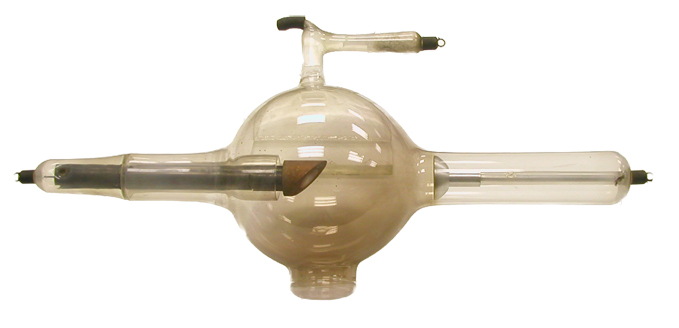Kny-Scheerer (Kayess) Tube (1918-1925)

This particular tube was manufactured by the Kny-Scheerer Company of New York City. It once belonged to Carl Braestrup at New York’s Francis Delafield Hospital, but whether or not he used it is unknown.
As is common for late model cold cathode tubes, there are only two electrodes: a cathode and an anode.
The side of the cup-shaped aluminum cathode is visible inside the glass arm projecting from the right side of the bulb (as seen in the photo).
The anode projects into the bulb from the left side of the tube. The target (probably tungsten) is embedded in the copper block at the anode’s free end. Since the target incorporates a massive heat sink, this is known as a “heavy anode” tube.
The glass appendage on the top of the tube is a regulator (aka regenerative device). When the gas pressure inside the tube became too low, the regulator helped increase it—at least temporarily. For a detailed discussion of how this worked, read the Introduction to Gas Discharge X-ray Tubes.
One feature worth noting: the projection on the bottom of the glass bulb at the point where the X-ray beam would exit the tube. This is a sure sign that the tube was intended for therapy rather than radiography (imaging). Although it is hard to tell, the glass does not seem to be any thinner at the projection than anywhere else. If it is thinner, and that can't be ruled out, the purpose would have been to increase the transmission of low energy X-rays. One possibility is that the projection was used to help standardize the distance between the tube and the patient during treatment. In other words, the projection would have been placed close to, or in contact with, the patient’s body. It is also possible that the projection helped position some type of collimator (e.g., a lead glass extension) of the sort used with a Piffard tube, or to help orient the tube inside a shielded enclosure so that the X-ray beam would be directed through a small opening in the shield.
Note the glass jacket that extends most of the way along the length of the anode. This might have served two functions, intended or otherwise. First, the glass would prevent stray electrons from striking the side of the anode and producing X-rays. It is true that X-rays would still be produced by electrons striking the glass, but they would be of lower intensity than the X-rays produced by electrons striking the metal components of the anode. We want the anode to emit X-rays, but they should come from the face of the target, not the stem. Second, the purpose of the glass mantle might have been related to a phenomenon observed by Hittorf: that a glass surface near an electrode will accumulate a static charge, and that this charge reduces the emission of electrons from the electrode. The emission of electrons from the anode would be a potential problem during periods of reversed current. See the Introduction for more information concerning the problem of reversed currents.
Kny-Scheerer Company was a fairly small operation that produced medical equipment. Before the first world war the company used a crowned snake coiled around a scepter as their trademark. After WW I they switched the trademark to "Kayess," as in K and S for Kny-Scheerer. The only visible markings on the tube are the words "Kayess Products" stamped onto the copper jacket of the anode, something that indicates that the tube was manufactured after WW I. For some reason, they seemed to have moved around a fair bit: 404-410 W 27th Street; 56-68 W 23rd Street, and; 225-233 Fourth Street.
Size: Approximately 5" diameter bulb, 18" long
Donated by Cecilia and Maureen Mooney.
References
- ERN Grigg. Trail of the Invisible Light. Charles C Thomas 1965.
- GWC Kaye. X-Rays. Longmans, Gree and Co. London. 1929.
- Ronne, P., Nielsen, A.B.W. Development of the Ion X-ray Tube. 1986.
